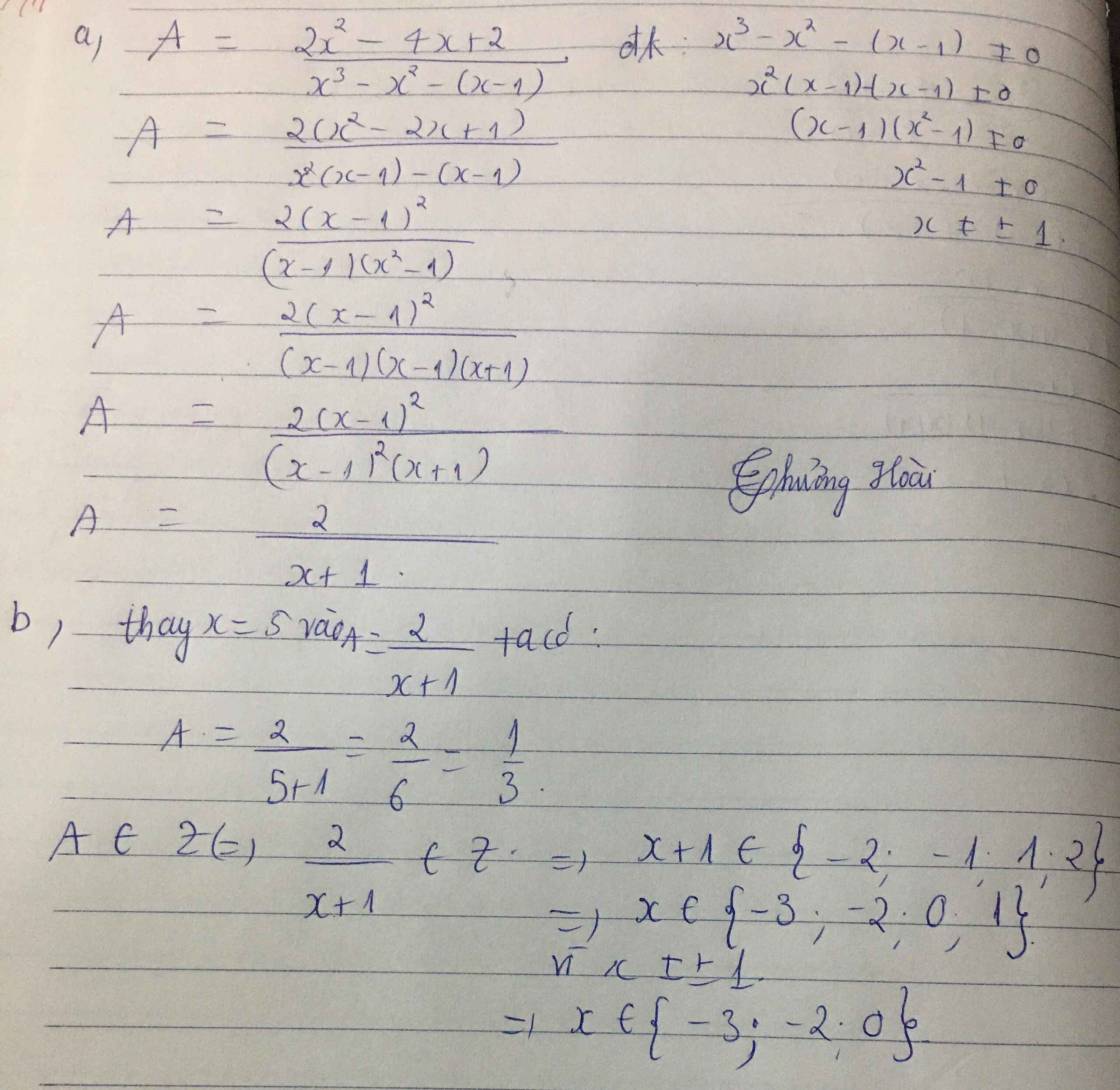cho biểu thức: A= 2x^2-4x+2 / x^3-x^2-(x-1)
a) Rút gọn A
b) tính giá trị cảu A khi x=5
c) Tìm giá trị nguyên của x để biểu thức A có giá trị nguyên.
Hãy nhập câu hỏi của bạn vào đây, nếu là tài khoản VIP, bạn sẽ được ưu tiên trả lời.



a: \(A=\dfrac{x^2-2x+2x^2+4x-3x^2-4}{\left(x-2\right)\left(x+2\right)}=\dfrac{2x-4}{\left(x-2\right)\left(x+2\right)}=\dfrac{2}{x+2}\)
a, \(\dfrac{x}{x+2}\) + \(\dfrac{2x}{x-2}\) -\(\dfrac{3x^2-4}{x^2-4}\)
= \(\dfrac{x}{x+2}+\dfrac{2x}{x-2}-\dfrac{3x^2+4}{x^2-4}\)
= \(\dfrac{x}{x+2}+\dfrac{2x}{x-2}-\dfrac{3x^2+4}{\left(x+2\right)\left(x-2\right)}\)
= \(\dfrac{x\left(x-2\right)+2x\left(x+2\right)-3x^2-4}{\left(x+2\right)\left(x-2\right)}\)
= \(\dfrac{2x-4}{\left(x+2\right)\left(x-2\right)}=\dfrac{2\left(x-2\right)}{\left(x+2\right)\left(x-2\right)}=\dfrac{2}{x+2}\)
Có vài bước mình làm tắc á nha :>

a: \(A=\left(\dfrac{x}{x^2-4}+\dfrac{4}{x-2}+\dfrac{1}{x+2}\right):\dfrac{3x+3}{x^2+2x}\)
\(=\dfrac{x+4x+8+x-2}{\left(x-2\right)\left(x+2\right)}\cdot\dfrac{x\left(x+2\right)}{3\left(x+1\right)}\)
\(=\dfrac{6\left(x+1\right)\cdot x\left(x+2\right)}{3\left(x+1\right)\left(x-2\right)\left(x+2\right)}\)
\(=\dfrac{2x}{x-2}\)

a, ĐKXĐ: x\(\ne\) 1;-1;2
b, A= \(\left(\frac{x}{x+1}+\frac{1}{x-1}-\frac{4x}{2-2x^2}\right):\frac{x+1}{x-2}\)
=\(\left(\frac{2x^2-2x}{2\left(x+1\right)\left(x-1\right)}+\frac{2x+2}{2\left(x+1\right)\left(x-1\right)}+\frac{4x}{2\left(x-1\right)\left(x+1\right)}\right)\times\frac{x-2}{x+1}\)
=\(\frac{2x^2-2x+2x+2+4x}{2\left(x+1\right)\left(x-1\right)}\times\frac{x-2}{x+1}\)
=\(\frac{2x^2+4x+2}{2\left(x+1\right)\left(x-1\right)}\times\frac{x-2}{x+1}\)
=\(\frac{2\left(x+1\right)^2}{2\left(x+1\right)\left(x-1\right)}\times\frac{x-2}{x+1}\)
=\(\frac{x-2}{x-1}\)
c, Khi x= -1
→A= \(\frac{-1-2}{-1-1}\)
= -3
Vậy khi x= -1 thì A= -3
Câu d thì mình đang suy nghĩ nhé, mình sẽ quay lại trả lời sau ^^
a,ĐKXĐ:x#1; x#-1; x#2
b,Ta có:
A=\(\left(\frac{x}{x+1}+\frac{1}{x-1}-\frac{4x}{2-2x^2}\right):\frac{x+1}{x-2}\)
=\(\left(\frac{x\left(x-1\right)2}{\left(x+1\right)\left(x-1\right)2}+\frac{\left(x+1\right)2}{\left(x-1\right)\left(x+1\right)2}+\frac{4x}{2\left(x-1\right)\left(x+1\right)}\right):\frac{x+1}{x-2}\)
=\(\frac{2x^2-2x+2x+2+4x}{\left(x+1\right)\left(x-1\right)2}.\frac{x-2}{x+1}\)
=\(\frac{2x^2+4x+2}{\left(x+1\right)\left(x-1\right)2}.\frac{x-2}{x+1}\)
=\(\frac{2\left(x+1\right)^2}{\left(x+1\right)\left(x-1\right)2}.\frac{x-2}{x+1}\)
=\(\frac{x-2}{x+1}\)
c,Tại x=-1 ,theo ĐKXĐ x#-1 \(\Rightarrow\)A không có kết quả
d,Để A có giá trị nguyên \(\Rightarrow\frac{x-2}{x+1}\)có giá trị nguyên
\(\Leftrightarrow x-2⋮x+1\)
\(\Leftrightarrow x+1-3⋮x+1\)
Mà \(x+1⋮x+1\Rightarrow3⋮x+1\)
\(\Rightarrow x+1\inƯ\left(3\right)=\left\{1;-1;3;-3\right\}\)
\(\Rightarrow x\in\left\{0;-2;2;-4\right\}\)
Mà theo ĐKXĐ x#2\(\Rightarrow x\in\left\{0;-2;-4\right\}\)
Vậy \(x\in\left\{0;-2;-4\right\}\)thì a là số nguyên

a) Ta có: A = \(\frac{x+1}{x-2}+\frac{x-1}{x+2}+\frac{x^2+4x}{4-x^2}\)
A = \(\frac{\left(x+1\right)\left(x+2\right)}{\left(x-2\right)\left(x+2\right)}+\frac{\left(x-1\right)\left(x-2\right)}{\left(x+2\right)\left(x-2\right)}-\frac{x^2+4x}{\left(x-2\right)\left(x+2\right)}\)
A = \(\frac{x^2+3x+2+x^2-3x+2-x^2-4x}{\left(x-2\right)\left(x+2\right)}\)
A = \(\frac{x^2-4x+4}{\left(x-2\right)\left(x+2\right)}\)
A = \(\frac{\left(x-2\right)^2}{\left(x-2\right)\left(x+2\right)}=\frac{x-2}{x+2}\)
b) Với x = 4 => A = \(\frac{4-2}{4+2}=\frac{2}{8}=\frac{1}{4}\)
c) ĐKXĐ: \(\hept{\begin{cases}x-2\ne0\\x+2\ne0\\4-x^2\ne0\end{cases}}\) <=> \(\hept{\begin{cases}x\ne2\\x\ne-2\\x\ne\pm2\end{cases}}\) <=> \(x\ne\pm2\)
Ta có: A = \(\frac{x-2}{x+2}=\frac{\left(x+2\right)-4}{x+2}=1-\frac{4}{x+2}\)
Để A nhận giá trị nguyên dương <=> \(1-\frac{4}{x+2}\) nguyên dương
<=> \(-\frac{4}{x+2}\) nguyên dương <=> -4 \(⋮\)x + 2
<=> x + 2 \(\in\)Ư(-4) = {1; -1; 2; -2; 4; -4}
Lập bảng:
| x + 2 | 1 | -1 | 2 | -2 | 4 | -4 |
| x | -1(tm) | -3(tm) | 0(tm) | -4(tm) | 2(ktm) | -6(tm) |
Vậy ....

ĐKXĐ : \(x\ne\pm3\)
a) \(A=\left(\frac{2x}{x-3}-\frac{x+1}{x+3}+\frac{x^2+1}{9-x^2}\right):\left(1-\frac{x-1}{x+3}\right)\)
\(A=\left(\frac{-2x\left(3+x\right)}{\left(3-x\right)\left(3+x\right)}-\frac{\left(x+1\right)\left(3-x\right)}{\left(x+3\right)\left(3-x\right)}+\frac{x^2+1}{\left(3-x\right)\left(3+x\right)}\right):\left(\frac{x+3}{x+3}-\frac{x-1}{x+3}\right)\)
\(A=\left(\frac{-2x^2-6x+x^2-2x-3+x^2+1}{\left(3-x\right)\left(3+x\right)}\right):\left(\frac{x+3-x+1}{x+3}\right)\)
\(A=\left(\frac{-8x-2}{\left(3-x\right)\left(3+x\right)}\right):\left(\frac{4}{x+3}\right)\)
\(A=\frac{-2\left(4x+1\right)\left(x+3\right)}{\left(3-x\right)\left(3+x\right)4}\)
\(A=\frac{-\left(4x+1\right)}{2\left(3-x\right)}\)
\(A=\frac{4x+1}{2\left(x-3\right)}\)
b) \(\left|x-5\right|=2\)
\(\Rightarrow\orbr{\begin{cases}x-5=2\\x-5=-2\end{cases}\Rightarrow\orbr{\begin{cases}x=7\\x=3\end{cases}}}\)
Mà ĐKXĐ x khác 3 => ta xét x = 7
\(A=\frac{4\cdot7+1}{2\cdot\left(7-3\right)}=\frac{29}{8}\)
c) Để A nguyên thì 4x + 1 ⋮ 2x - 3
<=> 4x - 6 + 7 ⋮ 2x - 3
<=> 2 ( 2x - 3 ) + 7 ⋮ 2x - 3
Mà 2 ( 2x - 3 ) ⋮ ( 2x - 3 ) => 7 ⋮ 2x - 3
=> 2x - 3 thuộc Ư(7) = { 1; -1; 7; -7 }
=> x thuộc { 2; 1; 5; -2 }
Vậy .....
a) ĐKXĐ: \(x\ne\pm3\)
\(A=\frac{2x\left(x+3\right)-\left(x+1\right)\left(x-3\right)-\left(x^2+1\right)}{x^2-9} : \frac{x+3-\left(x-1\right)}{x+3}\)
\(A=\frac{2x^2-6x-x^2+2x+3-x^2-1}{x^2-9} : \frac{4}{x+3}\)
\(A=\frac{-4x+2}{x^2+9} : \frac{4}{x+3}\)
\(A=\frac{2\left(1-2x\right)}{\left(x+3\right)\left(x-3\right)}\cdot\frac{x+3}{4}=\frac{1-2x}{2x-6}\)
b)
Có 2 trường hợp:
T.Hợp 1:
\(x-5=2\Leftrightarrow x=7\)(thỏa mã ĐKXĐ)
thay vào A ta được: A=\(-\frac{13}{8}\)
T.Hợp 2:
\(x-5=-2\Leftrightarrow x=3\)(Không thỏa mãn ĐKXĐ)
Vậy không tồn tại giá trị của A tại x=3
Vậy với x=7 thì A=-13/8
c)
\(\frac{1-2x}{2x-6}=\frac{1-\left(2x-6\right)-6}{2x-6}=-1-\frac{5}{2x-6}\)
Do -1 nguyên, để A nguyên thì \(-\frac{5}{2x-6}\inℤ\)
Để \(-\frac{5}{2x-6}\inℤ\)thì \(2x-6\inƯ\left(5\right)=\left\{\pm1;\pm5\right\}\)
Do 2x-6 chẵn, để x nguyên thì 2x-6 là 1 số chẵn .
Vậy không có giá trị nguyên nào của x để A nguyên

\(a,A=\dfrac{x^2-3x+2+x^2+3x+2-x^2+2x-4}{\left(x+2\right)\left(x-2\right)}=\dfrac{x^2+2x}{\left(x+2\right)\left(x-2\right)}\\ A=\dfrac{x\left(x+2\right)}{\left(x+2\right)\left(x-2\right)}=\dfrac{x}{x-2}\\ b,A=\dfrac{x-2+2}{x-2}=1+\dfrac{2}{x-2}\in Z\\ \Rightarrow x-2\inƯ\left(2\right)=\left\{-2;-1;1;2\right\}\\ \Rightarrow x\in\left\{0;1;3;4\right\}\)